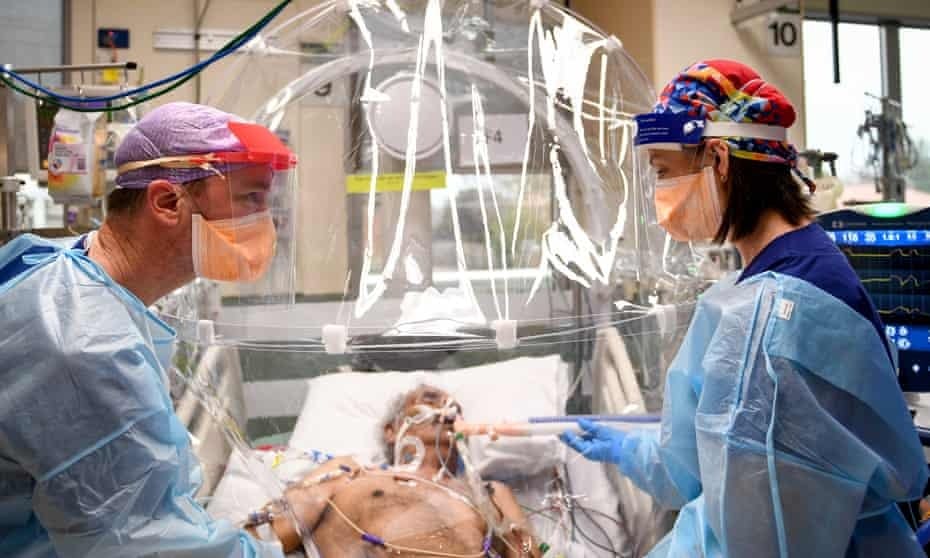Labor lets COVID-19 rip, again

“You need to understand that we’ve got 20 to 25,000 Australians who will die this year because of COVID, a good 15 percent increase on our normal death rate. These are people who would otherwise have lived. I didn’t hear that really stressed today.”
—Brendan Crabb, director of the Burnet Institute
“We think it’s good for business.”
—Andrew MacKellar, chief executive of the Australian Chamber of Commerce and Industry
It’s as sickening as it is predictable. A national cabinet meeting led by Prime Minister Anthony Albanese has decided to scrap all COVID-19 isolation requirements for the vast majority of people in Australia from 14 October. Financial support for those isolating, except for workers in health and aged care, will also be cut from that date.
Anyone who has no sick leave due to casual employment will have to work without federal support, and face the awful choice between potentially infecting others or being plunged into poverty. The same choice faces those who have exhausted any paid sick leave entitlement—usually two weeks. That is plenty of us, considering we have endured four COVID-19 waves over the past twelve months, with large numbers affected by the well-documented poor health that often follows infection.
Government and business have claimed that an “immunity wall” from vaccination and prior infection will keep the virus at bay, and have asserted that COVID-19 is just like the flu or any other respiratory disease. This is a straight-out lie.
Raina MacIntyre, Brendan Crabb and Nancy Baxter—three of Australia’s best-known public health experts—point out in an article for the Conversation: “There have been 288 deaths from influenza so far this year compared to more than 12,000 deaths from COVID”.
And this horrific short-term death toll is actually only the tip of the iceberg. In a blistering interview with the ABC, Brendan Crabb pointed out:
“It’s an infection of the organs in your body, of your heart and of your brain and of your blood vessels. And it’s leaving this long COVID burden that is possibly worse than the acute burden.” Even for those with mild cases, infection and reinfection increases the risk of long-term health problems.
In a sign of just how appalling the new policy is, the body which usually signs off on public health measures, the Australian Health Protection Principal Committee, was not asked for advice on this occasion. Instead, it was left to national Chief Medical Officer Paul Kelly to stammer his way through an incoherent justification for this strategy of unmitigated mass infection.
Victorian Chief Health Officer Brett Sutton has a record of pragmatically adapting to the political winds on COVID-19. But the nearly total abandonment of health protections was clearly too much for him. Sutton tweeted, “Sleepwalking into COVID is not a strategy I would recommend”, linking to an article in Science discussing highly infectious new variants that can evade immunity from prior infection and vaccination.
These variants are already producing a significant new surge in the UK. COVID-19 hospitalisations in England have risen 48 percent in a week. If and when this wave crashes over Australia, we will face it with even less public health protection than in the most recent surge, which left a wreckage of death (and most likely of long COVID) much worse than any previous wave. For those who are particularly vulnerable, the isolation and stress caused by the progressive scrapping of protective health measures will only be intensified.
Those at the front line of treating people affected by COVID-19 have also expressed serious concern about the consequences of dropping isolation requirements. A statement from the Australian Nursing and Midwifery Association expressed concern that the full impact of the reduction in the isolation period had not yet been felt, and that “removing all isolation periods for the general community, particularly in the context of uncertainty regarding the emergence of new variants and potential waning immunity, will put further pressure on our healthcare systems”. “We believe the suggestion that COVID-isolation is a matter of ‘personal responsibility’”, the union goes on to say, “is just a way of Governments shifting their responsibility onto the individual when it should be theirs”.
The new policy is particularly shocking given that the history of the pandemic in Australia was initially one of state governments and the population at large succeeding—unexpectedly and against steep odds—in eliminating the virus. But the time bought by that success was largely wasted. Instead of pouring extra money into expanding the health system and mitigation measures like better ventilation and air filtering, Australian governments bowed, one after another, to the interests of business.
In a profit-driven system, health care in general is seen as a high fixed cost to be minimised, rather than as a prime necessity of a decent life. Increasing those costs or letting public health (or public anything) get in the way of business as usual, has always been opposed by business interests, both small and large. Even straightforward and effective measures to reduce the spread of COVID-19, such as staff wearing masks, might remind customers that a pathogen that can kill and maim may be hanging in the air, potentially reducing cash flow.
So the latest move to scrap isolation rules and isolation payments is appalling, but no surprise. All the signs have been present since Albanese took office. As I wrote in Red Flag in July: “In all its essentials, Labor’s policy is a continuation of the policies [of the former Morrison Liberal government] that have led to a new and severe burden of ill health being imposed on the population—and on the working class and poor in particular”.
The handling of the COVID-19 pandemic has always been a battle that pitted public health against a highly profitable “business as usual”. If anyone was still in any doubt, the scrapping of isolation rules and isolation payments makes it absolutely clear which side Labor is on in that contest.